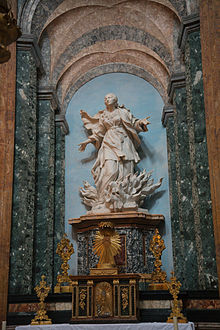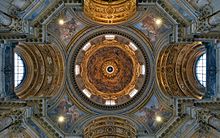Sant'Agnese in Agone
| Sant'Agnese in Agone | ||
|---|---|---|
| patronage | St Agnes | |
| consecration day | 17 Jan 1672 | |
| parish | San Lorenzo in Damaso | |
| diocese | Rome | |
| Cardinal Deacon : | Gerhard Ludwig Mueller | |
| address |
Via SM dell'Anima 30/A 00186 Roma |
|
Sant'Agnese in Agone ( Italian ; German: St. Agnes in Agone - from the former name of Piazza Navona as Piazza in Agone, Latin: Ecclesia Sanctae Agnetis in Agone ) is a Catholic church in the district of Parione , the Rione VI the historic center of Rome . It is a rectorate church of the parish of San Lorenzo in Damaso .
Sant'Agnese in Agone is also the titular church of the Cardinal Deacon of Sant'Agnese in Agone . Title holder since February 22, 2014 is Gerhard Ludwig Müller (prefect of the Congregation for the Doctrine of the Faith until July 2017 ), who took possession of his titular church on September 14, 2014. From 1517 it was already the titular church of a cardinal priest , until this title was dissolved in 1654 and transferred to Sant'Agnese fuori le mura .
The church is named after the early Christian Roman martyr Agnes of Rome , who, according to legend, was to be paraded naked by her pursuers at this point in the stadium ( Greek agon : competition) of Domitian, whereupon her body was miraculously covered by her long hair and was thus hidden from the view of onlookers.
The church was formerly the parish and monastery church of the Order of Minor Regular Clerics (Caracciolini). She is also sometimes referred to as "Sant'Agnese de Agone", "Sant'Agnese al Circo Agonale", "Sant'Agnese de Cryptis Agonis" or "Sant'Agnese in Piazza Navona".
position
The church is centrally located on the western long side of Piazza Navona .
story
The earliest evidence of a Christian cult site at the site of today's Church of Sant'Agnese in Agone can be found in the Itinerary of Einsiedeln and substantiate it for the 8th century. It is assumed that there was an oratory there before , but cannot be proven. At first the building was probably looked after by Basilian monks . Since 920 Benedictines from Farfa Abbey have lived there. The Abbot of Farfa was in 1001 by decree of Emperor Otto III. transferred the area around today's Piazza Navona as property. Previously, the area of the former Stadium of Domitian had belonged to the possessions of the monastery at the Basilica of Saint Paul Outside the Walls since Leo IV (847 to 855) .
Under Pope Calixtus II , the oratory was converted into a small basilica and consecrated on January 27, 1123. At that time, despite belonging to the Farfa Abbey, secular priests were already working in the church. Built under Calixtus II, the basilica remained almost unchanged until the end of the 16th century. The main portal of the church was in what is now Via Santa Maria dell'Anima ; there was also a smaller gate to the Piazza Navona, which probably originally led to the playing field of the stadium. The church itself was located under the vaults of the former stadium stands.
The church had numerous tombs such as that of Paolo Bussa de' Leoni , father of Saint Francesca Romana . She was baptized there in 1384 .
Pope Nicholas V (1447 to 1455) transferred ownership of the church to the monasteries of Sant'Andrea at Flumine near Ponzano and San Silvestro on Monte Soratte . In addition, the use of the building as a parish church has been documented since 1419. On July 6, 1517, Leo X elevated the church to the status of a titular church and on May 15, 1597, under Clement VIII , handed it over to the Order of Minor Regular Clerics, who gradually redesigned the poor building, as a monastery church.
The baroque new building

Under Innocent X (1644 to 1655) the construction of the baroque church began, which replaced the medieval church. The Pamphilj family, to which he belonged, had long had their residence in Piazza Navona. From 1644 onwards the Palazzo Pamphilj was renewed and considerably expanded, but it was not until around 1650 that the intention to make S. Agnese the papal mausoleum and to integrate it into the palace complex can be seen. On May 29, 1652, Innocent X abolished the parish, the Caracciolini Fathers were moved within five days from their monastery building to the church of San Lorenzo in Lucina . On August 14 of the same year, he ordered the building site to be donated to his nephew Camillo Pamphilj . A day later, the foundation stone was laid by his five-year-old son Giovanni Battista.
In 1652 the new building was started according to a design by the house architect of the Pamphilj, Girolamo Rainaldi (1570-1655). Initially, an octagonal, mausoleum-like building with cross arms, a mighty vestibule and a relatively low dome was planned. In addition, a flight of steps leading into the Piazza Navona was planned. Roman travertine from Tivoli or the Roman Forum and Carrara marble were used for the building . In addition, the façade cladding made it possible to reuse the stadium's seating steps. Innocent X donated twelve columns from the Lateran Basilica to the church on January 21, 1653 , which were no longer needed there after the reconstruction. With the papal breve In supremo militantis ecclesiae of February 7 of the same year, he secured his nephew Camillo or his successors born in primogeniture the church patronage over the church.
In July 1653, construction on the church came to a standstill after a dispute between the Pope and Camillo Pamphilj, whose architect Carlo Rainaldi (1611-1691), son of Girolamo, had meanwhile taken over the construction management. The main subject of the dispute was the planned flight of stairs, which Camillo wanted to enlarge considerably against the will of the Pope. Eventually, Rainaldi was withdrawn from execution and Camillo Pamphilj was also expelled from the building process after differences had probably arisen between Pamphilj and his mother Olimpia Maidalchini , who was very influential at the papal court. She in turn wanted to pass the further construction on to her favorite Giovanni Lorenzo Bernini , but Innocent X decided in favor of Francesco Borromini , under whose direction the construction work was continued on August 7, 1653.
Borromini modified the original design, replacing the porch with a concave curved facade, adding a tambour to the dome , raising it significantly, and redesigning the interior to better accentuate the eight marble columns that were intended. The completion of the church was even worked on on Sundays and holidays with such great haste and pressure that workers who refused to work on holidays were forcibly driven to the construction site by sbirrs on behalf of the pope . Not least because of this eagerness to build, the dome shell was able to be completed in the summer of 1654.
In the process of rededication to the private church of the Pamphilj family, on 5 October Innocent X revoked the cardinal title held by Cardinal Baccio Aldobrandini and transferred it to Sant'Agnese fuori le mura .
After the death of Innocent X, it was feared that the building would be handed over to Bernini by the influential Olimpia Maidalchini, so that Borromini gradually withdrew from the building activity and this stalled again. The inactivity of the builders' hut prompted the new Pope Alexander VII to urge Olimpia Maidalchini to complete the church quickly, since the Piazza Navona was blocked with travertine blocks. She handed construction supervision back to her son Camillo. At Camillo's request, Borromini extended the construction with the two flanking bell towers, which were not previously foreseen. However, differences of opinion between the architect and the client about the progress of the work soon led to Borromini delaying the work. On July 2, 1657 he was relieved of the construction management. Carlo Rainaldi completed the construction between 1657 and 1672, completing the towers and the dome lantern. In 1667 Gian Lorenzo Bernini made decisive changes to Borromini's façade design.
The walls are elaborately clad on the inside with white and red-spotted marble ( brocatello ). The altars are decorated with precious white marble reliefs, mainly by Domenico Guidi (high altar), Antonio Raggi and Ercole Ferrata . The paintings in the dome represent the Glory of Paradise . They were created between 1670 and 1689 by Ciro Ferri and Giovanni Battista Gaulli , known as Baciccia.
On January 17, 1672, the not yet completely completed church was consecrated.
The remains of Innocent X, initially buried in St. Peter's Basilica , were transferred to Sant'Agnese in Agone in 1677 and buried in the Capella di Santa Francesca Romana . It was not until 1729 that Giovanni Battista Maini created the marble funerary monument above the main portal.
In 1949 the church was extensively restored and in 1998 Pope John Paul II raised it to the title of diaconate.

literature
- Walter Buchowiecki: "Handbook of the Churches of Rome. The Roman sacred building in history and art from the early Christian period to the present.” Vol. 1, Vienna 1967, pp. 284-296.
- Gerhard Eimer : La fabbrica di S. Agnese in Navona: Roman architects, builders and craftsmen in the age of nepotism. Two volumes, Stockholm 1970/71.
- Heinz-Joachim Fischer : Rome. Two and a half millennia of history, art and culture in the Eternal City. DuMont Buchverlag, Cologne 2001, ISBN 3-7701-5607-2 , p. 232.
- Anton Henze: "Art Guide Rome". Philipp Reclam GmbH, Stuttgart 1994, ISBN 3-15-010402-5 , pp. 142-144.
- Martin Raspe: "Borromini and Sant'Agnese in Piazza Navona. From the papal tomb to the residential church of the Pamphili”. In: Roman yearbook of the Bibliotheca Hertziana 31, 1996, pp. 313-368.
web links
- Official site (Italian, English)
- RomaViva: Sant'Agnese in Agone – The basilica by Borromini in Piazza Navona (English, Italian)
itemizations
- ↑ Report on the seizure on the website of the diocese of Regensburg
Coordinates: 41° 53′ 55.6″ N , 12° 28′ 21.2″ E



